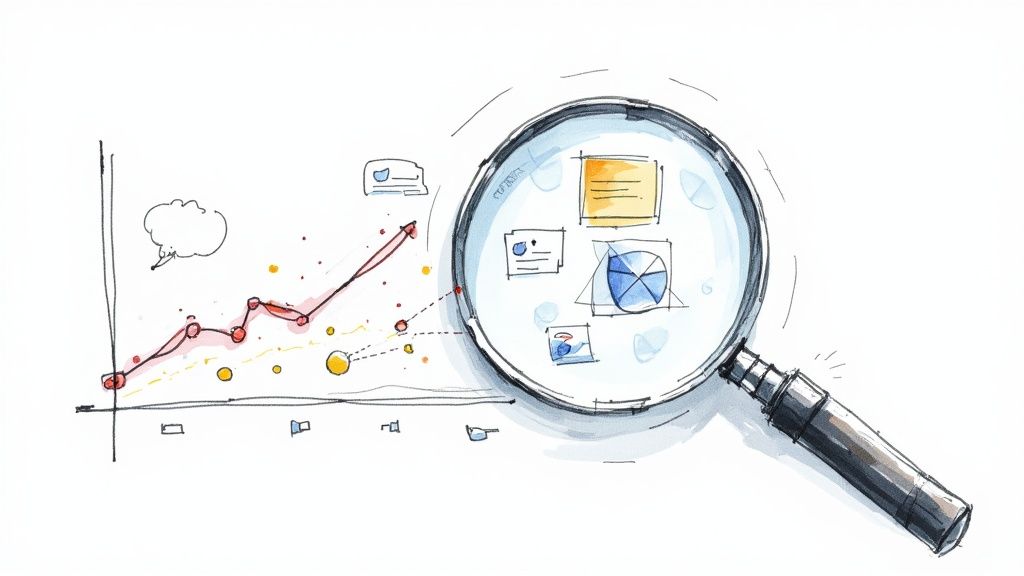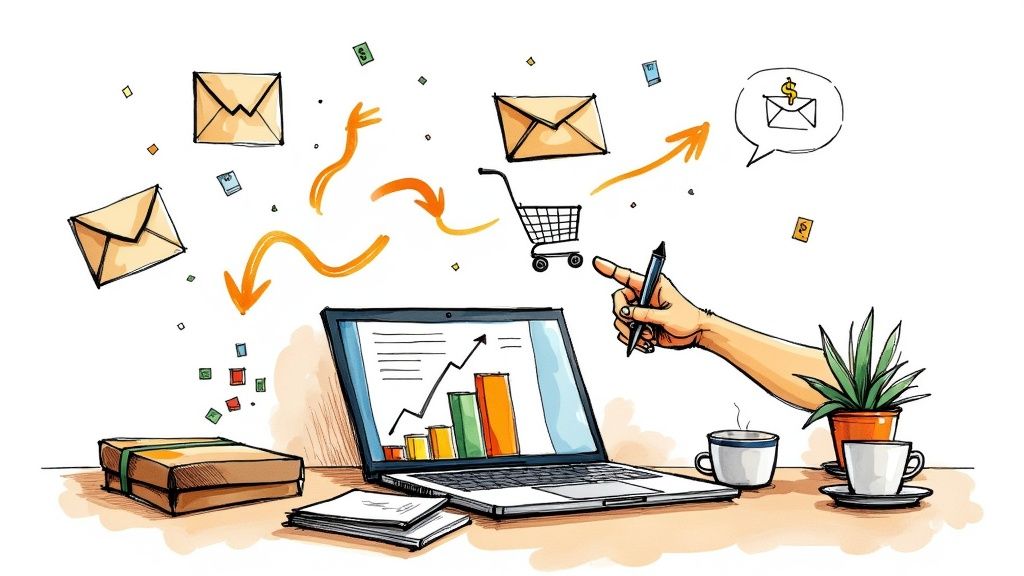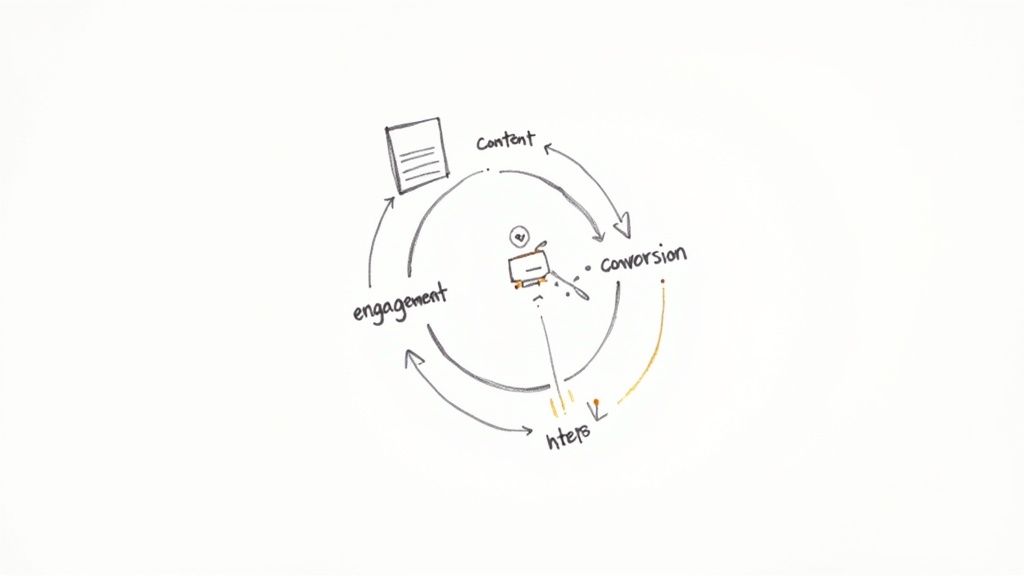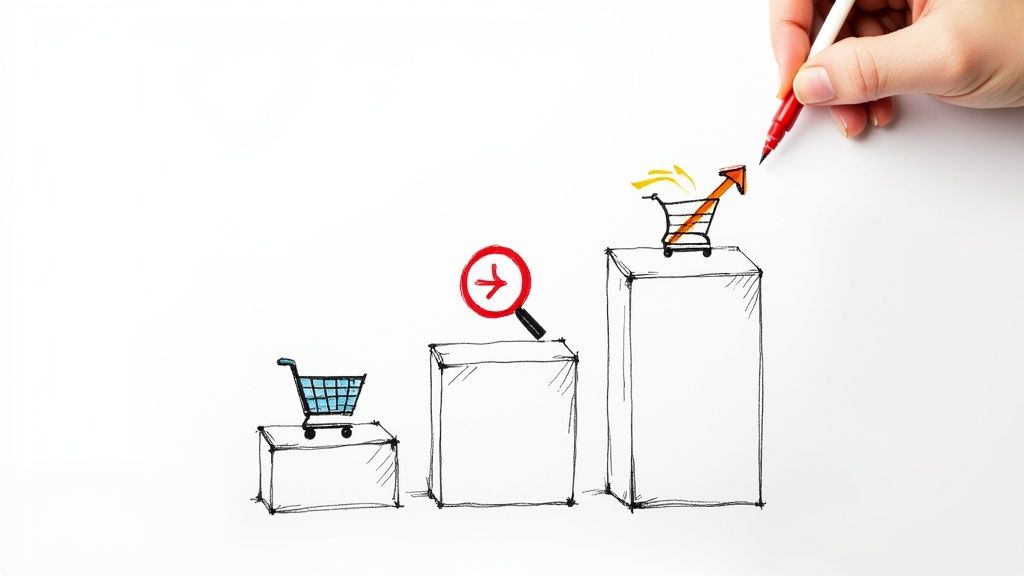Scaling Ecommerce Business: Your Growth Playbook That Works

17 mins
6/4/2025
Joe Ervin
- scaling ecommerce business
- ecommerce growth
- business scaling
- online growth
- ecommerce strategy
Recognizing Your Perfect Scaling Moment

Many e-commerce business owners dream of expansion, picturing a future brimming with orders and increased revenue. But often, they hesitate, waiting for the "perfect" time. This ideal moment rarely appears on its own.
Instead, it's the result of planning, market understanding, and smart risk-taking. Knowing how to spot your optimal scaling moment is crucial for realizing your business's full potential.
Identifying the Green Lights for Growth
How can you tell when you're truly prepared to scale your e-commerce business? It's not simply about luck or hitting a specific revenue target. Focus on these key indicators:
Consistent Demand Exceeding Supply: Are you frequently out of stock? Are shipping times longer than normal because you're struggling to fulfill orders? These are clear signs that market demand is outpacing your current capacity.
Positive Customer Feedback and High Retention: Happy customers who keep coming back are essential for successful scaling. Positive reviews, repeat business, and a high customer lifetime value all demonstrate a loyal customer base ready to expand with you.
Strong Unit Economics and Profitability: Before expanding significantly, ensure your business is financially healthy. Understanding your Customer Acquisition Cost (CAC), Average Order Value (AOV), and Lifetime Value (LTV) is crucial. Profitable unit economics fuel sustainable growth.
Streamlined and Efficient Operations: Scaling magnifies existing operational inefficiencies. Carefully review your order fulfillment process, inventory management, and customer service. If these areas are already stretched thin, scaling will likely worsen the problems.
Capitalizing on Market Trends
Timing is everything in e-commerce scaling. The global e-commerce market has seen substantial growth in recent years, especially since the COVID-19 pandemic. In 2020 alone, global e-commerce sales jumped by $897 billion, a record increase reflecting the pandemic's impact on consumer habits.
Growth has slowed since then, but e-commerce continues to expand, projected to reach $6.88 trillion by 2025. You can find detailed statistics at Statista. Understanding market dynamics and identifying relevant trends in your niche offers significant scaling advantages. For instance, a sudden rise in demand for a specific product type is a prime opportunity for businesses already equipped to meet that demand.
Avoiding Premature Scaling and Missed Opportunities
Scaling too soon can be harmful. If your operations, finances, or customer base aren't ready, rapid growth can lead to cash flow issues, overburdened teams, and unhappy customers.
However, waiting too long is also risky. Competitors may seize market share, and you could lose valuable momentum. The key is finding the balance—the point where your business is strong enough to handle greater demand and the market is poised for expansion.
This involves thorough analysis, honest self-evaluation, and the confidence to act decisively when the moment is right. By recognizing the indicators, understanding the market, and laying a solid foundation, you can seize your perfect scaling moment and unlock your business's full potential.
Building Your Growth-Ready Tech Foundation

Want to scale your ecommerce business? It takes more than just hoping for more sales. You need a strong tech foundation that can handle significant growth. Your current platform might work fine now, but can it handle a 10x increase in traffic and orders? This section explores the key technology choices that can make or break your scaling journey.
Choosing a Platform That Scales
Your ecommerce platform is the heart of your tech foundation. Choosing the right one is crucial. A platform that struggles under pressure can cause website crashes, lost sales, and unhappy customers.
When evaluating platforms for a growing ecommerce business, consider factors like scalability, flexibility, and cost.
- Scalability: Can the platform handle growing traffic, transactions, and data without slowing down?
- Flexibility: Does it allow for customizations and integrations with other important tools as your business changes?
- Cost: Will the pricing structure remain affordable as you grow, or will it become too expensive?
For example, a platform with limited bandwidth might handle your current traffic, but struggle with a sudden influx of customers during a holiday sale. This underscores the importance of choosing a platform built for scalability.
Essential Infrastructure Components
Beyond just the platform, other infrastructure components are essential for effectively scaling an ecommerce business.
Hosting: Reliable hosting is crucial for website uptime and speed, even during traffic spikes. Cloud-based hosting solutions like Amazon Web Services (AWS) or Google Cloud Platform (GCP) can automatically scale resources based on demand.
Order Management System (OMS): A robust OMS helps automate order processing, fulfillment, and inventory management. This streamlines operations as order volume grows. Popular OMS platforms include ShipStation and Orderhive.
Customer Relationship Management (CRM): A CRM helps manage customer interactions, personalize marketing, and improve customer service as your customer base grows. Salesforce and HubSpot are widely-used CRM platforms.
These systems work together to ensure smooth operations and a positive customer experience. Investing in these core components early will prepare you for smooth and efficient scaling. You might find this helpful: How to master your ecommerce tech stack.
To illustrate the core technology requirements at different business stages, let's look at the following table:
Essential Technology Stack Components for Scaling: Comparison of core technology requirements at different business growth stages.
| Component | Startup Stage | Growth Stage | Scale Stage | Investment Priority |
|---|---|---|---|---|
| Ecommerce Platform | Basic features, affordability | Advanced features, integrations | Enterprise-grade, high availability | High |
| Hosting | Shared or basic cloud hosting | Dedicated cloud hosting, auto-scaling | Multi-region cloud architecture, CDN | High |
| OMS | Manual or basic software | Automated OMS with integrations | Advanced OMS with customization | Medium |
| CRM | Basic contact management | Marketing automation, sales pipeline management | Advanced analytics, custom integrations | Medium |
This table highlights the increasing complexity and investment required for each component as your business scales. While a startup might prioritize a basic ecommerce platform and affordable hosting, a scaling business needs to invest in enterprise-grade solutions and multi-region cloud architecture.
Architecting for Seamless Expansion
Building your tech stack with future growth in mind is essential. This involves a few key strategies:
- Modular Design: Choose systems that can be easily integrated with each other and scaled independently.
- API Integrations: Use APIs to connect different systems and automate data flow between them.
- Data Analytics: Implement robust data analytics tools to track key performance indicators (KPIs) and find areas for improvement.
This approach allows your tech infrastructure to adapt and grow alongside your business, enabling data-driven decisions that improve performance and maximize ROI.
Avoiding Costly Mistakes
Many businesses underestimate the importance of a growth-ready tech foundation. This can lead to several issues:
- Website Crashes: A platform that can't handle increased traffic can crash during peak periods, leading to lost sales and damage to your reputation.
- Fulfillment Delays: Inefficient order management can lead to shipping delays and frustrated customers as order volume grows.
- Data Silos: Systems that don't communicate effectively can create data silos, making it difficult to make informed business decisions.
These mistakes are expensive to fix and can hinder your scaling efforts. Investing in the right technology from the beginning is crucial for long-term success. Prioritizing a scalable, flexible, and integrated tech foundation sets your ecommerce business up for sustainable growth and helps you avoid common pitfalls.
Streamlining Operations For Explosive Growth

As your e-commerce business expands, operational complexities inevitably increase. This growth can lead to bottlenecks that hinder further progress. This section explores how successful businesses manage surging order volumes without a proportional increase in expenses. We'll delve into practical automation tactics and outline best practices for streamlining fulfillment, inventory management, and customer service for genuinely sustainable e-commerce growth.
Automating for Efficiency
Automation is essential for scaling an e-commerce business. Consider it the foundation of a well-oiled machine: every part operates smoothly and automatically, minimizing manual work and boosting efficiency.
Order Fulfillment: Automating order processing, picking, packing, and shipping reduces manual errors and accelerates delivery times. This is especially vital during peak seasons and promotional campaigns.
Inventory Management: Automated inventory tracking and reordering prevents stockouts and overstocking, optimizing warehouse space and cash flow. Picture a system that automatically reorders popular products when inventory dips below a defined level.
Customer Service: Chatbots and automated email responses can handle frequently asked questions, allowing your customer support team to focus on complex issues. This enhances customer satisfaction and minimizes response times.
Optimizing Fulfillment and Inventory
Streamlined fulfillment and effective inventory management are crucial for scaling. They form the core of a thriving e-commerce business, particularly during periods of rapid expansion.
Warehouse Management: Optimizing warehouse layout and establishing efficient picking routes reduces order processing and shipping times.
Shipping Strategies: Collaborating with multiple carriers and negotiating competitive shipping rates lowers costs and enhances flexibility.
Real-time Inventory Tracking: Employing a system that offers real-time insight into inventory levels allows for precise demand forecasting and efficient stock replenishment.
These processes are vital for guaranteeing smooth operations and customer satisfaction as your business grows. E-commerce sales are forecast to hit $8.3 trillion by 2025, a 55.3% jump from 2021. This expansion is driven by increased internet access, the growth of mobile commerce (over 70% of online purchases are now made on mobile devices), and the broad adoption of digital payment methods (more than half of all transactions use digital wallets). Discover more detailed statistics here. This underscores the importance of adaptable, streamlined operations for handling this rising volume.
Elevating Customer Service
Maintaining exceptional customer service becomes increasingly challenging as your e-commerce business scales. However, prioritizing customer retention is crucial for long-term success. Explore our guide on How to Master E-commerce Customer Retention.
Proactive Communication: Keeping customers updated on order status, potential delays, and promotions builds trust and sets clear expectations.
Personalized Support: Customizing customer interactions based on purchase history and preferences creates a positive experience and encourages loyalty.
Multi-Channel Support: Providing support across multiple channels like email, phone, and live chat allows customers to contact you via their preferred method.
By adopting these strategies, you can construct a solid operational framework to support your e-commerce scaling ambitions. This approach enables you to manage growing order volumes while delivering outstanding customer service and optimizing profitability.
Mastering The Money Game While Scaling

Scaling an ecommerce business isn't just about boosting sales. It requires a deep understanding of your finances. Cash flow, especially, can determine the success or failure of a rapidly expanding business. This section explores proven strategies to navigate these financial complexities, using insights from founders who've successfully scaled their businesses.
Understanding Unit Economics at Scale
As your business grows, understanding unit economics is crucial. These metrics measure the profitability of each individual sale. Keeping a close eye on the following is key:
Customer Acquisition Cost (CAC): This is the cost of acquiring a new customer. As you scale, your CAC needs to be manageable and shouldn't outpace revenue growth.
Average Order Value (AOV): This metric tracks the average value of each order. Increasing AOV through techniques like upselling, cross-selling, and product bundles can significantly boost profitability.
Lifetime Value (LTV): LTV represents the total revenue generated by a customer over their entire relationship with your business. A high LTV typically indicates strong customer loyalty and sustainable growth.
These metrics give you a clear view of your financial health and help inform strategic decisions. For instance, a high CAC might require reevaluating your marketing spend or exploring more cost-effective acquisition channels.
Funding Strategies For Sustainable Growth
Scaling often needs extra capital. But choosing the right funding strategy is vital for maintaining control and aligning with your long-term vision. Here are some options:
Bootstrapping: Funding growth through internal cash flow is sustainable but can limit expansion speed.
Venture Capital: Securing funding from investors can fuel rapid growth, but it often involves giving up some equity and facing external pressure.
Debt Financing: Loans can provide the necessary capital without sacrificing ownership, but they come with repayment obligations.
Each option has its own pros and cons. The best choice depends on your business needs, risk tolerance, and growth goals.
Maintaining Profitability While Investing in Growth
Balancing profitability with investment in growth is a major scaling challenge. This requires careful planning and execution. Here are some successful strategies:
Prioritize Efficiency: Streamlining operations and automating processes can free up resources for growth.
Strategic Pricing: Optimizing your pricing strategy to balance profit and competitiveness is crucial for maximizing revenue.
Data-Driven Decisions: Using data analytics like those available from tools such as Google Analytics can help you track key metrics and make informed investment decisions.
These strategies ensure sustainable growth and contribute to long-term profitability. Prioritizing investments with the highest return on investment (ROI) is also important.
Key Financial Metrics For Scaling
To better illustrate financial management during scaling, let's look at a helpful table:
To help you navigate these complex financial waters, we've compiled a table outlining crucial financial metrics for scaling ecommerce businesses.
Key Financial Metrics for Scaling Ecommerce Businesses: Critical financial KPIs to monitor during different scaling phases with benchmark ranges.
| Metric | Definition | Growth Stage Target | Scale Stage Target | Warning Signs |
|---|---|---|---|---|
| CAC | Cost to acquire a new customer | Industry average or lower | Decreasing over time | Increasing CAC, exceeding LTV |
| AOV | Average value of each order | Industry average or higher | Gradually increasing | Stagnant or decreasing AOV |
| LTV | Total revenue generated by a customer | 3x CAC or higher | Increasing over time | Decreasing LTV, approaching CAC |
| Conversion Rate | Percentage of website visitors who make a purchase | 2-5% or higher | Gradually increasing | Declining conversion rate |
This table emphasizes the importance of monitoring key metrics throughout your scaling journey. By understanding these indicators and applying the strategies discussed, you can effectively manage your finances while scaling your ecommerce business and build a solid foundation for long-term success.
Creating Marketing Systems That Scale Profitably
Scaling your marketing isn't about spending more; it's about building systems that remain efficient even with increased volume. It's about creating a streamlined operation where all parts work together seamlessly to acquire customers profitably across multiple channels. This section explores how successful ecommerce businesses build these marketing operations.
Advanced Segmentation: Targeting the Right Customers
As your customer base grows, it becomes more diverse. Advanced segmentation lets you divide your audience into smaller, more focused groups based on more than just basic demographics. This might include purchase history, website behavior, engagement levels, and even psychographic factors.
For example, instead of targeting "women aged 25-34," you could target "women aged 25-34 who have purchased skincare products in the last six months and frequently read blog posts about anti-aging." This detailed approach enables highly personalized messaging that resonates with each segment, resulting in higher conversion rates and a better return on investment. It's like having a personalized conversation with each customer, addressing their specific needs.
Automation Workflows: Maximizing Efficiency
Marketing automation is more than scheduled emails. It's about building intelligent workflows that nurture leads, onboard new customers, and encourage repeat purchases. Think of it as a series of automated actions triggered by specific customer behaviors.
- Abandoned Cart Emails: When a customer adds items to their cart but doesn't complete the purchase, an automated email reminding them and offering a small incentive can recapture lost sales.
- Welcome Series: When a new customer joins your email list, a welcome series introduces your brand, showcases key products, and encourages their first purchase.
- Post-Purchase Follow-Up: After a customer completes a purchase, a follow-up email thanking them and suggesting relevant products can drive repeat business.
These automated workflows free up your time to focus on strategy while ensuring every customer receives timely and personalized communication. You might find this helpful: How to master marketing automation for ecommerce.
Attribution Models: Making Smart Spending Decisions
Understanding where your marketing budget is most effective is crucial for profitable scaling. Attribution models help you understand which touchpoints in the customer journey are most influential in driving conversions. It's not always as simple as the last click. A customer might discover your brand through a social media ad, then visit your website several times before finally buying through an email promotion.
By analyzing different attribution models, you can gain a deeper understanding of the customer journey and allocate your budget to the most effective channels and campaigns. This data-driven approach optimizes your spending and maximizes your ROI as you scale.
Optimizing for Different Customer Segments
Just as your messaging should be personalized, so should your marketing funnels. A first-time customer has different needs and motivations than a loyal, repeat customer.
- New Customer Acquisition: Concentrate on building awareness, highlighting key benefits, and offering attractive incentives for their first purchase.
- Customer Retention: Focus on building relationships, providing personalized recommendations, and offering exclusive rewards to encourage loyalty and repeat business.
By optimizing your funnels for different customer segments, you can maximize conversions and build a sustainable customer acquisition system that maintains profitability as you grow.
Building a Testing Framework
Continuous testing is essential for scaling your marketing effectively. A/B testing different ad creatives, landing pages, and email subject lines can show you what resonates with your audience. This helps you identify successful strategies quickly, optimizing your campaigns for maximum impact. This iterative process of testing and refinement is essential for staying competitive as you scale. A strong testing framework lets you experiment with different approaches, learn from your mistakes, and continuously improve your marketing performance. This ensures you're not just scaling your efforts but also scaling your success.
Leading Teams Through Hypergrowth
Scaling an ecommerce business isn't just about systems and processes; it's about the people involved. Rapid growth can put a strain on teams faster than it breaks technology. This means that building a resilient, adaptable team is crucial for navigating the challenges of hypergrowth. This section explores the human side of scaling, drawing on insights from leaders who have successfully guided teams through periods of significant expansion.
Hiring Strategies for Rapid Growth
When rapid scaling is essential, finding the right talent becomes paramount. Traditional hiring processes can be too slow and cumbersome for rapid expansion. Adaptable strategies are key.
Prioritize Culture Fit: Look for candidates who align with your company's values and work ethic, even if their experience isn't extensive. A strong culture encourages collaboration and resilience during periods of rapid change.
Embrace "Culture Add": While culture fit is important, also seek candidates who can bring valuable new perspectives and enrich your existing culture. This diversity of thought can lead to better problem-solving and innovation.
Leverage Recruitment Technology: Use tools like applicant tracking systems (ATS) and online assessment platforms to streamline your hiring process and efficiently find the best talent.
Build a Talent Pipeline: Don't wait for open positions to connect with potential candidates. Actively network and build relationships to have a pool of qualified individuals ready when you need them.
For example, a small ecommerce business experiencing a sudden increase in demand could quickly become overwhelmed relying solely on traditional hiring methods. By using recruitment technology and focusing on both culture fit and culture add, they can quickly onboard talented individuals who can immediately contribute.
Maintaining Culture and Communication
As your team grows, maintaining a strong culture and open communication becomes more difficult. However, it's even more important during times of rapid change.
Regular Communication: Implement regular team meetings, all-hands meetings, and company-wide updates to keep everyone informed and on the same page. This helps maintain the cohesive rhythm of a unified team.
Transparent Leadership: Openly communicate your company's vision, goals, and challenges. Transparency fosters trust and ensures the team feels involved in the company's journey.
Invest in Team Building: Cultivate strong relationships among team members through professional development and social activities.
Encourage Feedback: Create an environment where feedback is actively sought and appreciated. This can identify areas for improvement and ensure everyone's voice is heard.
Building Scalable Management Structures
Your management structure needs to adapt as your team grows. A flat organizational structure might work for a small startup, but it can become unwieldy during rapid growth.
Develop Leadership Depth: Invest in training and development programs to equip your managers with the skills they need to effectively lead expanding teams. This prepares your business for future growth.
Delegate Effectively: Empower your managers to make decisions and take ownership of their responsibilities. This creates a more nimble and responsive organization, providing growth opportunities for others.
Create Clear Roles and Responsibilities: As your team grows, establishing clear roles and responsibilities is vital to avoid confusion and redundancy. This streamlines operations and creates clear paths for career progression.
Implement Performance Management Systems: Track individual and team performance, provide consistent feedback, and recognize excellent contributions.
By prioritizing these strategies, you can build a team that doesn't just survive hypergrowth, but thrives in it. Investing in your team's growth and well-being is fundamental to successfully scaling your ecommerce business. Remember, your people are your greatest asset.
Key Takeaways
Your journey through scaling an ecommerce business has explored crucial aspects, from recognizing the opportune moment to expand to guiding teams through periods of hypergrowth. This section distills these strategies into actionable steps you can implement immediately, providing a practical roadmap for scaling success. This roadmap is built on real-world experience and proven results, offering phase-by-phase guidance, detailed checklists, and important warning signs to be aware of. Each takeaway emphasizes actionable strategies with clear measurement criteria, enabling you to build sustainable growth momentum.
Phase-By-Phase Guidance and Timelines
Scaling isn't a uniform process. It develops in distinct phases, each with its own set of priorities and timelines. This structured approach helps you manage the intricacies of growth and avoid feeling overwhelmed.
Phase 1: Foundation Building (6-12 Months): This phase concentrates on establishing a strong core foundation in areas like product-market fit, customer acquisition, and operational efficiency. Key performance indicators (KPIs) include conversion rates, customer acquisition cost (CAC), and customer lifetime value (LTV).
Phase 2: Strategic Expansion (12-24 Months): Here, the focus transitions to expanding your product offerings, exploring new markets, and developing your team. Key metrics include market share, revenue growth, and team performance.
Phase 3: Sustainable Scaling (24+ Months): This phase prioritizes establishing systems and processes that support long-term, consistent growth. Key metrics include profitability, customer retention, and employee satisfaction. As your business evolves, these phases offer a structured pathway for sustainable expansion.
Checklists For Each Growth Stage
To make these phases actionable, utilize detailed checklists specific to each growth stage. These checklists provide a clear roadmap for prioritizing tasks and ensuring nothing is missed.
Startup Stage: Focus on refining your product, validating your target market, and cultivating your initial customer base.
Growth Stage: Concentrate on optimizing your marketing initiatives, streamlining your operations, and assembling a high-performing team.
Scale Stage: Prioritize constructing scalable systems, automating processes, and fostering leadership depth within the organization.
These checklists convert broad strategies into specific tasks, making the scaling process more manageable. For example, during the startup stage, a checklist item might be "Define your ideal customer profile" or "Develop a content marketing strategy." In the scale stage, a checklist item might be "Implement an automated order fulfillment system" or "Develop a leadership training program."
Warning Signs and Consolidation Strategies
Not every scaling endeavor is successful. Recognizing potential warning signs early can help you avert costly missteps.
Increasing CAC: If your customer acquisition cost is escalating faster than your revenue, it indicates your marketing endeavors are becoming less efficient.
Declining Conversion Rates: A decrease in conversion rates may suggest issues with your website, product offerings, or marketing message.
High Employee Turnover: Frequent employee departures can signal underlying cultural issues or inadequate management practices.
If you observe these warning signs, consider pausing your scaling efforts and focusing on consolidating your existing progress. This might involve refining your strategy, enhancing operational efficiency, or investing in team development. A strategic retreat can be the best preparation for future growth.
Actionable Strategies and Measurement Criteria
Each phase of scaling necessitates specific actions and corresponding metrics to track progress. This ensures accountability and allows for data-driven adaptations. Imagine establishing clear targets for each metric, then consistently reviewing your progress and making necessary adjustments. This continual optimization is critical for generating momentum and maintaining a healthy growth trajectory. This structured approach, combined with actionable strategies, checklists, and awareness of potential warning signs, equips you to scale your ecommerce business sustainably, minimizing common pitfalls while maximizing your growth potential.





